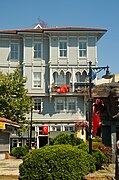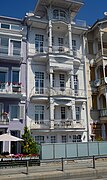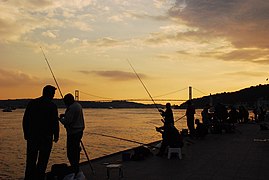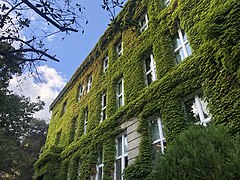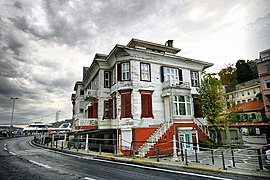Arnavutköy
Arnavutköy | |
|---|---|
Istanbul | |
| District | Beşiktaş |
| Population (2022) | 3,574 |
| Time zone | UTC+3 (TRT) |
Arnavutköy (lit. '
The existence of a mosque, church and synagogue in close proximity to one another serves as a reminder of Arnavutköy's past cosmopolitanism.
The coast road is usually lined with anglers and small fishing boats frequently pass Arnavutköy; the fresh fish caught is sometimes sold to the local seafood restaurants. At the eastern end of Arnavutköy the coast juts out to form Akıntıburnu (the Cape of the Current) where the waters of the Bosphorus once flowed so powerfully that small boats had to be towed round it.[5]
Infrequent
History

In antiquity, the area was known as Asomato and Anáplus. In 1468, Sultan
In 1863,
According to the
Arnavutköy used to be famous for its
Architecture
The waterfront at Arnavutköy is lined with some of the most picturesque late 19th and early 20th-century wooden houses to survive along the Bosphorus, many of them decorated in Art Nouveau style.[9] While they look very individual, it is thought that most of the decorative elements on the facades were actually mass-produced.
Education
The American Academy for Girls moved to Arnavutköy in 1914, but in 1923 moved to the Bağlarbaşı neighbourhood of Üsküdar on the Asian side of the city where it continues to accept students as the Üsküdar American Academy.
See also
Gallery
References
- ^ ISBN 9783406590634. "Europäische Migranten sind verantwortlich für Ortsnamen wie Arnavutköy («Albanerdorf»)"
- ^ a b Coşkun, Burhanettin; Yolcu, Tuğba (28–29 April 2016). "Küreselleşen dünyada göç sorunları ve Türkiye'nin bölgesel rolü [Migration issues in the globalizing world and Turkey's regional role]". Aralik University: 97. Retrieved 12 June 2019.
{{cite journal}}: Cite journal requires|journal=(help) "İlk defa Türkiye'ye Fatih Sultan Mehmet zamanında getirilen Arnavutlar, 1468 senesinde İstanbul’un Arnavutköy semtine yerleştirilmişlerdir. Arnavutköy, 1468 yılında Arnavut göçmenler tarafından oluşturulmuştur. Kültürümüzün temel taşlarından olan semtlere (Arnavutköy, Arnavutkaldırımı)" - ^ Mahalle, Turkey Civil Administration Departments Inventory. Retrieved 12 July 2023.
- TÜİK. Retrieved 12 July 2023.
- ISBN 9789752307346.)
{{cite book}}: CS1 maint: numeric names: authors list (link - . "Some examples of prominent migrations such as migration of Albanians who were placed in Arnavutköy in 1468"
- Reşat Ekrem Koçu, İstanbul Ansiklopedisi, vol. 2 (İstanbul 1958-1971), p. 1.041
- ^ Papastratis Th., Γειτονιές του Βοσπόρου [Neighborhoods of Bosporus], Athens, 2003, p. 72
- ISBN 0847819892.)
{{cite book}}: CS1 maint: numeric names: authors list (link

